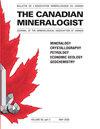The Hexagonal ↔ Orthorhombic Structural Phase Transition in Claringbullite, Cu4FCl(OH)6
IF 1.5
4区 地球科学
Q3 MINERALOGY
引用次数: 1
Abstract
Frustrated magnetic phases have been a perennial interest to theoreticians wishing to understand the energetics and behavior of quasi-chaotic systems at the quantum level. This behavior also has potentially wide applications to developing quantum data-storage devices. Several minerals are examples of such phases. Since the definition of herbertsmithite, Cu3ZnCl2(OH)6, as a new mineral in 2004 and the rapid realization of the significance of its structure as a frustrated antiferromagnetic phase with a triangular magnetic lattice, there has been intense study of its magnetic properties and those of synthetic compositional variants. In the past five years it has been recognized that the layered copper hydroxyhalides barlowite, Cu4BrF(OH)6, and claringbullite, Cu4FCl(OH)6, are also the parent structures of a family of kagome phases, as they also have triangular magnetic lattices. This paper concerns the structural behavior of claringbullite that is a precursor to the novel frustrated antiferromagnetic states that occur below 30 K in these minerals. The reversible hexagonal (P63/mmc) ↔ orthorhombic (Pnma or Cmcm) structural phase transition in barlowite at 200−270 K has been known for several years, but the details of the structural changes that occur through the transition have been largely unexplored, with the focus instead being on quantifying the low-temperature magnetic behavior of the orthorhombic phase. This paper reports the details of the structural phase transition in natural claringbullite at 100−293 K as studied by single-crystal X-ray diffraction. The transition temperature has been determined to lie between 270 and 293 K. The progressive disordering of Cu at the unusual trigonal prismatic Cu(OH)6 site on heating is quantified through the phase transition for the first time, and a methodology for refining this disorder is presented. Key changes in the behavior of Cu(OH)4Cl2 octahedra in claringbullite have been identified that suggest why the Pnma structure is likely stabilized over an alternative Cmcm structure. It is proposed that the presence of a non-centrosymmetric octahedron in the Pnma structure allows more effective structural relaxation during the phase transition than can be achieved by the Cmcm structure, which has only centrosymmetric octahedra.六边形↔ Claringbullite,Cu4FCl(OH)6中的正交结构相变
沮丧的磁相一直是希望在量子水平上理解准混沌系统的能量学和行为的理论家们的兴趣所在。这种行为在开发量子数据存储设备方面也有潜在的广泛应用。几种矿物就是这种相的例子。自2004年将草铁矿Cu3ZnCl2(OH)6定义为一种新矿物,并迅速认识到其结构作为具有三角形磁晶格的受抑反铁磁相的重要性以来,人们对其磁性和合成成分变体的磁性进行了深入研究。在过去的五年中,人们已经认识到,层状羟基卤化铜巴洛石,Cu4BrF(OH)6,和澄清钡石,Cu4FCl(OH)5,也是一个kagome相家族的母体结构,因为它们也具有三角形磁晶格。本文研究了在这些矿物中30K以下出现的新的受抑反铁磁态的先驱——澄清钡石的结构行为。可逆六边形(P63/mmc)↔ barlowite在200−270 K下的正交(Pnma或Cmcm)结构相变已经知道好几年了,但通过该转变发生的结构变化的细节在很大程度上尚未被探索,重点是量化正交相的低温磁性行为。本文报道了用单晶X射线衍射研究的天然澄清钡石在100−293K下的结构相变的细节。转变温度已确定在270和293K之间。首次通过相变量化了加热时Cu在不寻常的三棱柱形Cu(OH)6位点的渐进无序,并提出了细化这种无序的方法。已经确定了Cu(OH)4Cl2八面体在澄清矿中的行为的关键变化,这表明了为什么Pnma结构可能在替代的Cmcm结构上稳定。有人提出,Pnma结构中非中心对称八面体的存在允许在相变过程中比只有中心对称八面的Cmcm结构更有效的结构弛豫。
本文章由计算机程序翻译,如有差异,请以英文原文为准。
求助全文
约1分钟内获得全文
求助全文
来源期刊

Canadian Mineralogist
地学-矿物学
CiteScore
2.20
自引率
22.20%
发文量
45
审稿时长
4-8 weeks
期刊介绍:
Since 1962, The Canadian Mineralogist has published papers dealing with all aspects of mineralogy, crystallography, petrology, economic geology, geochemistry, and applied mineralogy.
 求助内容:
求助内容: 应助结果提醒方式:
应助结果提醒方式:


